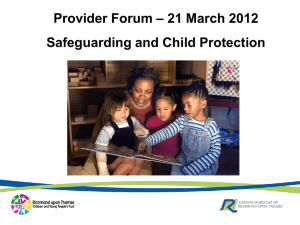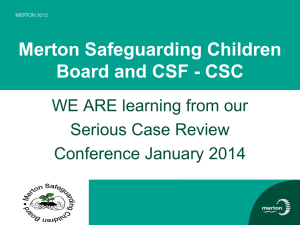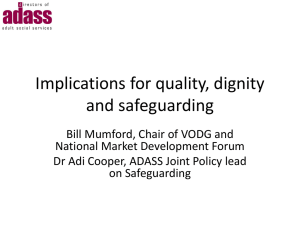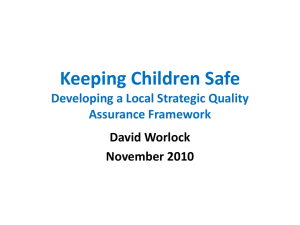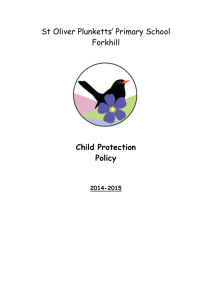Safeguarding in schools presentation
advertisement
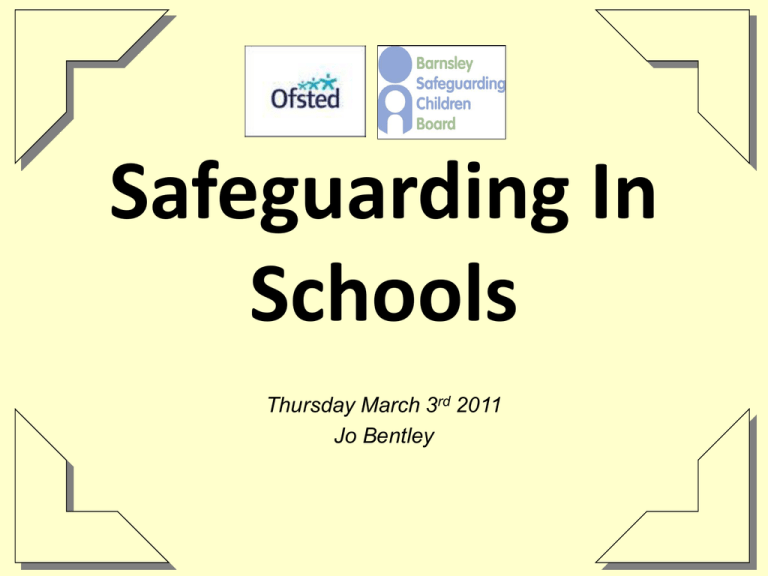
Safeguarding In Schools Thursday March 3rd 2011 Jo Bentley Single Central Record 1 - IS THE SCR IN PLACE? -Who completes it and keeps it up to date? -How often is it updated and checked? -Who monitors it and is ultimately responsible for it? Single Central Record 2 - IDENTITY CHECKS -What documents were seen? -Are the documents recorded acceptable? -Who saw them? Note: Although recording addresses and NI details are good practice, they are not requirements. Single Central Record 3, 4, 5 – CRB / List 99 checks -Have all staff (all those paid to work at the school) who have regular and unsupervised access to children been appropriately checked? 8 – DETAILS OF CHECK -Record when check carried out. -Record who carried out the check. Single Central Record 6 – SUPPLY TEACHERS -Is it clear on the SCR if the supply teacher is from an agency or employed by the school directly? -Does the school have written confirmation that the required checks have been carried out by the agency? Single Central Record 6 – SUPPLY TEACHERS -If employed by the school directly, have the appropriate checks been made? Single Central Record 7 – OTHERS -Are those who work regularly or intensively with children included on the SCR? *volunteers *governors who work regularly in school as volunteers Single Central Record 9 - QUALIFICATIONS -Does SCR record the qualifications required to do the job? Have all teachers evidenced their QTS? Has headteacher evidenced NPQH? HLTA, Business Manager, TAs… *Record n/a where there is no qualification required to do the job. Single Central Record 10 – ‘RIGHT TO WORK’ -Does the school employ anyone who is not a national of a European Economic Area? -Evidence of eligibility to work in UK e.g. passport (driving licence not acceptable) Single Central Record And Finally… -Do not leave any empty cells. -Use Excel to flag up when ‘renewals’ are due. -Never delete an employee or volunteer – paste their details onto a ‘left’ page. Single Central Record - Organise in tabs or pages according to roles in school. - Make use of the SCR to evidence your training record. Single Central Record Policy 1. Aims and purpose. 2. Secure framework for the workforce. Code of Conduct 3. Links to other policies (see list). 4. Wider provision. 5. Responsibilities and expectations when identifying and reporting concerns. Policy 6. Named Designated Leads. 7. Procedures – Cause for Concern and Allegations against staff. 8. Whistleblowing. 9. Reporting and recording concerns (within school and to outside agencies). Policy 10. Training (inc. temporary staff). 11. Role of governing body (see governor monitoring record). 12. Implementation, monitoring and evaluation. 13. Parents and carers (link to contact sheet). 14. Accessible and easy to understand. Policy Cause for Concern 1. Identifying a cause for concern A cause for concern is an action, observation or discussion that makes you feel anxious or worried about the wellbeing or safety of a child. This could be a change in behaviour or a comment from a young person. Cause for Concern 2. Recording a Concern Written record by the person with the concern using the CAUSE FOR CONCERN FORM. Paper copies must be kept in classrooms. Discuss and pass written record to designated lead asap. Cause for Concern 3. Dealing with the concern No investigation, just clarification. Immediate and follow-up action taken and recorded on the Cause for Concern form. Cause for Concern 4. Monitoring the concern Share information as appropriate and record. Set up Vulnerable Pupil File. Complete Monitoring Record Sheet for all further action. Cause for Concern 5. Monitoring and evaluating the impact of action taken. Monthly monitoring meeting to review live and dormant cases. -Monitor agreed actions have taken place. -Evaluate impact of these actions. -Agree next steps. -Quality assure written records. Safeguarding Pupils at Hoyland Common Primary School HCPS Single Central Record IDENTITY Address Evidence of Date of Birth and eligibility to work Evidence in the UK NI Number NI Evidence Brown Mrs 33,Black Lane z43 1gt 28/10/1948 Passport Wage Slip Green Mrs 24,White Street S74 0BL White Mrs 15 S70 5JS CLERICAL/ADMIN SUPPORT 15/05/1977 Passport JOB ROLES SAP Number Job Title 00012492 Admin Officer 00021355 Parent Link Worker 10008872 Business Manager Passport ABC123456 31/01/1964 Passport Wage Slip Passport Wage Slip QUALIFICATIONS Date Commenced Date Left Qualification Required Qualification Evidenced 29/10/1984 n/a pre Sept -09 01/12/2003 n/a pre Sept -10 16/02/2010 AAT SAFE RECRUITMENT CHECKS CRB Evidence seen (date/by CRB Clearance whom) Confirmed CRB Disclosure Ref no/Date Received VH VH BMBC BMBC 001258457065 - 16/11/09 001260362177 - 01/12/09 16/11/12 pre Sept -09 01/12/12 pre Sept -09 pre Sept -09 pre Sept -09 16/11/09 16/11/09 16/11/12 16/11/12 PA BMBC 001239205460 - 15/06/09 15/06/12 16/11/09 16/11/12 Renewal Date Written Reference Written Reference 1 2 Safeguarding Training Renewal Date Safeguarding and Child Protection Policy • Very clear intent •Named people •Cause for concern procedure in place •Additional guidance at back •Went through step by step with all staff and governors •Needs to be school specific •Works for you and your pupils 2010 Hoyland Common Primary School Safeguarding and Child Protection Policy T. Banham & S. Harrison Reviewed by Governing body: 11/25/2010 Cause for Concern Procedure Cause for Concern Procedures A ‘Cause for Concern’ is an action, observation or discussion that makes you feel anxious or worried about the well-being or safety of a child. • Agreement on what a cause for concern is • A clear definition • Step by step process All causes for concern must be recorded immediately and in writing on the cause for concern record sheet by the person with the concern. This must then be passed to the designated teacher immediately, who will decide on the appropriate actions, completing the ‘for designated teacher use’ section of the cause for concern sheet. Even if this results in no further action a vulnerable pupils and family file would be raised. This will include: Vulnerable Pupil Information Sheet Monitoring record sheet Cause for Concern Form Sticker on the front of the folder indicating any other siblings This folder is placed in the ‘live’ Vulnerable pupils and families section Make other staff aware that a Vulnerable pupils and families file has been raised – raise in staff meeting/ briefing Any further discussions, telephone calls or meetings in relation to the child must be recorded on the monitoring record sheet. Designated teachers and other appropriate adults will hold a monthly meeting to discuss and review all live and dormant case files. This provides the opportunity for designated teacher to: Monitor that agreed actions have taken place Evaluate the impact of these actions Agree next steps Quality assure written records All further involvement and documentation must be stored in this file and nowhere else. Files will be stored in a secure place. Procedure in case of designated teacher absence: Contact other designated leads, if not possible Phone designated teacher and ask permission to access files Cause for Concern Sheets •In all classrooms •Brief training for all staff •First section completed by person with concern •Second section completed by Designated lead Cause For Concern Form CONFIDENTIAL Note: Please do not interpret what is seen or heard; simply record the facts. After completing the form, pass it immediately to the Acting Co-Head Teachers (T. Banham & S. Harrison) Name of child: Class: Siblings: Name of staff member completing form: Day: Date: (of observed behaviour / discussion / disclosure) Time: For Designated Teacher use Date & time received by designated teacher: Action Taken: By whom: Outcome: Discuss with child (if necessary): SEN Register /CAF / Agency involvement: Information shared with: Child’s Date of Birth: Address of Child: Name and Address of Child’s Parent or Carer (if different from above): Refer to Social Services: (when – date time, person spoken to, agreed actions) Cause for Concern record log •Attached to cause for concern sheet •Record any other issues/ conversation/ telephone calls/ multiagency work in relation to that child •Date, with actions, outcomes and people responsible Vulnerable Pupils Information sheet • Created after any child has been raised as a cause for concern •Front sheet in childs CFC folder •Useful information all at hand, particularly when talking to other agencies •Folder contains all information in chronological order •On front of folder also name and date of birth of any siblings Vulnerable Pupil Information Sheet Details of any interventions or appointments relating to this child should be added to the ‘Supporting Vulnerable Pupils Record Sheet which is stored in Teachershared/ SAFEGUARDING/Supporting Vulnerable Pupils – Record Sheets Surname Forenames Dates of Birth Home Address Home Telephone Number Parents’ Names Date added Register of Vulnerable Children Other Agencies Involved Named Contact Date of Initial Involvement Vulnerable pupils and families meeting • Held last Monday of each month – Without fail! • Designated leads • SENCo • Learning Mentor • Parent Link worker • Review all CFC children • Record anything on record log, aslo record nothing on log • 3 Months of nothing – file goes dormant • Files locked securely • Organised in alphabetical order • In Live, dormant and closed Involving Governors How? • Termly meetings with named Safeguarding Governors • Agreed focus – initially evaluating procedures against policy Why? • Named Safeguarding Governors report back to Full Governing Body meeting • Governors fully informed and able to discuss Safeguarding at school with outside agencies • Policy and procedures regularly reviewed and high profile maintained • Checks policy and procedures ensuring clarity of purpose and impact • Allows Governors to fulfil role as critical friend • Safeguarding is the Governors statutory responsibility. Involvement non-negotiable Governor monitoring record Governor: DM & G S Date: 25.11.10 Role: Safeguarding Governors Focus of Monitoring visit: Review of Policy and Procedure of Safeguarding Key lines of Enquiry: Findings Does the school comply with the safeguarding policy? Yes/No Does the policy have clear principles Implications The policy principles are clearly articulated that safeguard children and staff? Does the policy clearly identify Designated safeguarding staff? Does the policy clearly identify Designated safeguarding governors? Does the policy look at safer recruitment? Are safer recruitment procedures followed? Does the policy ensure the continued safety of pupils in relation to volunteers? Person/ people are identified: Clearly outlines the designated leads role: Explains how they will be effective designated leads: Explains the roles and responsibilities of the designated safeguarding governor Procedures are in place to ensure that volunteers are vetted and safe to be in school How is induction and training used to ensure children are safeguarded? A clear programme of training is outlined for all staff Are concerns dealt with effectively and with a high degree of tenacity? Are procedure for recording concerns robust? Are procedures followed effectively? In the case of the designated leads not being available is there a suitable procedure in place? Is safeguarding embedded in practice throughout school? Including pre and after school clubs Contractors During lessons Is priority given to ensure the ongoing confidentiality and sharing of appropriate information? Does the policy outline an expected code of conduct for staff? Does the policy refer to measure of when physical contact and restraint need to be used? Does the policy clearly identify the process to be followed if there are allegations against a member of staff? Are appropriate signing in procedures in place? Are parents and carers fully aware of safeguarding procedures? Date to fed back to FGB: Cause for Concern Ofsted Briefing for section 5 inspectors on safeguarding children. See pointers for inspectors selfevaluation checklist. See appendices for interview question prompts. Next Steps Consider carefully how you will implement, monitor, evaluate and review the model to make your safeguarding practice robust and relevant to your school. Final Note An outstanding tool will only have an outstanding impact in the hands of an outstanding practitioner under outstanding leadership.


